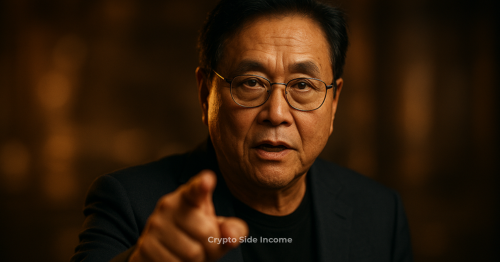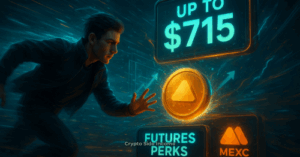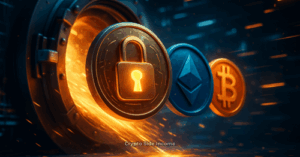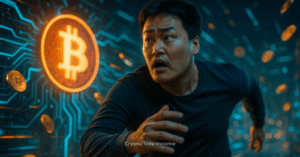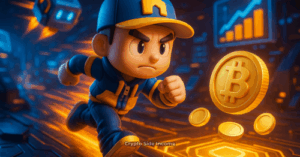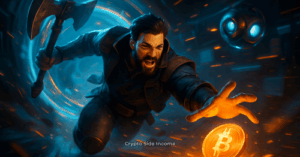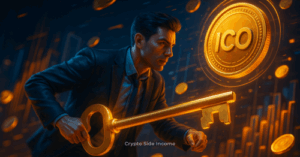Robert Kiyosaki Warns of ETF Risks, Recommends Physical Assets. In the latest investment advisory that has stirred debate across financial circles, Rich Dad Poor Dad author Robert Kiyosaki has once again made headlines. According to PANews, Kiyosaki has urged individual investors to look into gold, silver, and Bitcoin ETFs for their convenience, but not without issuing a stark warning. ETFs are mere paper representations, not the real deal.
This nuanced recommendation underscores a vital message for all classes of investors: Understand the difference between physical assets and ETFs, and know when to choose each. In this blog, we’ll break down what Kiyosaki means, why it matters, and how you can apply it to your investment strategy today.
Who Is Robert Kiyosaki?
Before diving into the analysis, it’s crucial to revisit who Robert Kiyosaki is. As the author of the best-selling personal finance book Rich Dad Poor Dad, Kiyosaki has influenced millions globally with his unique approach to financial literacy, wealth creation, and asset management.
Known for advocating real-world education over traditional schooling, Kiyosaki often challenges mainstream investment ideologies, making his views especially impactful in today’s fast-moving markets.
ETFs: Convenience with Limitations
What Are ETFs?
Exchange-Traded Funds (ETFs) are investment vehicles that allow people to invest in a variety of assets, like gold, silver, or Bitcoin, without owning the actual asset. Instead, you’re purchasing a share that represents a portion of a fund holding the asset.
Kiyosaki’s View on ETFs
Kiyosaki compared investing in ETFs to using a photo of a gun for self-defense. It’s symbolic but ineffective in a crisis. According to him, ETFs may offer ease of investment, especially for beginners or those with limited capital, but they do not provide the full security of owning the physical asset.
This metaphor raises a critical concern: In times of economic uncertainty or system collapse, owning the actual asset could be far more valuable than a paper contract.
Gold, Silver, and Bitcoin: Physical vs Paper

Gold and Silver
Gold and silver have historically been safe-haven assets. Investors turn to them during economic downturns, inflationary periods, or geopolitical instability.
- Physical Gold/Silver: Tangible, can be stored securely, immune to digital failure.
- Gold/Silver ETFs: Easy to buy/sell, liquid, but you’re relying on a custodian or financial institution.
Kiyosaki recommends physically holding gold and silver when possible, especially in preparation for economic disruptions.
Bitcoin
Bitcoin, as a digital asset, doesn’t have a “physical” form in the traditional sense, but it shares some characteristics with precious metals in terms of scarcity and decentralization.
- Physical Bitcoin (Self-Custody): Holding your Bitcoin in a private wallet gives you direct control over your investment.
- Bitcoin ETFs: Provide market exposure, but you don’t actually hold the coins; the provider does.
Again, Kiyosaki leans toward direct ownership to eliminate third-party risk.
When Are ETFs Still Useful?
Despite his warnings, Kiyosaki isn’t entirely dismissing ETFs. He acknowledges that for new investors, those with limited access to secure storage, or individuals seeking liquidity, ETFs can serve as a stepping stone into the world of alternative investments.
In short:
- ETFs = Accessibility and Liquidity
- Physical Assets = Security and Sovereignty
Investors must evaluate their own risk tolerance, capital availability, and investment horizon before making a choice.
The Bigger Picture: Wealth Preservation in 2025
Kiyosaki’s commentary comes at a time of increasing economic volatility. Inflation, political instability, and financial market unpredictability are pushing more investors to diversify their portfolios.
His advice serves as a timely reminder: Real wealth is not just about numbers on a screen. It’s about control, security, and having access to assets when you need them most.
How to Balance ETFs and Physical Assets
For a more resilient portfolio, consider a hybrid approach:
- Use ETFs to gain market exposure with limited capital or for shorter-term strategies.
- Gradually build holdings of physical gold, silver, and self-custodied Bitcoin to enhance long-term wealth preservation.
Tips for Smart Allocation:
- 20% in ETFs for liquidity and passive exposure.
- 80% in physical assets to protect against market shocks.
Make sure to also educate yourself on how to safely store physical assets, including using high-security vaults or cold wallets for Bitcoin.
Kiyosaki’s Final Message: Think Long-Term
Robert Kiyosaki’s core philosophy is rooted in financial independence through real assets. ETFs may provide short-term convenience, but true financial resilience lies in owning tangible, sovereign wealth.
His message is not about discarding modern financial tools, but about using them with awareness and strategy. Investors must realize that paper wealth can evaporate quickly in times of crisis, while real assets tend to hold intrinsic value.
Conclusion
Robert Kiyosaki’s latest statement serves as both a warning and a guide. While gold, silver, and Bitcoin ETFs offer an accessible entry point for investors, they are not a substitute for the security and sovereignty that comes with physical ownership. Investors are encouraged to educate themselves, diversify wisely, and always think long-term.
In an age where convenience often takes precedence, Kiyosaki reminds us of the timeless value of real, tangible wealth. Whether you’re just starting your investment journey or reassessing your strategy, understanding the trade-offs between ETFs and physical assets is essential for building lasting financial security.

I work as a content writer in the blockchain and cryptocurrency domain. I have a keen interest in exploring the world of digital assets, Web3, and emerging crypto technologies. My goal is to provide readers with easy-to-understand, engaging, and trustworthy insights, helping them stay informed and confident in the rapidly evolving world of crypto and blockchain.

